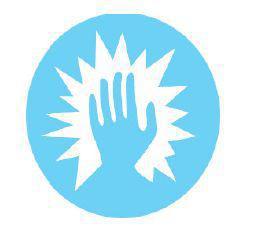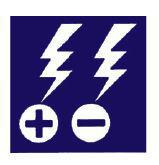SAS Urban Survival Handbook (10 page)
Read SAS Urban Survival Handbook Online
Authors: John Wiseman
Tags: #Health & Fitness, #Reference, #Survival, #Fiction, #Safety, #Self-Help, #Personal & Practical Guides, #General, #Survival Skills


WARNING
If someone is electrocuted by extremely high voltages from overhead cables, do not even get close to them. If you attempt to sever the contact with a ‘non-conductor’ such as a stick or a piece of clothing, the current will ‘jump’ the gap. Call for help.

SAVE A LIFE!
ELECTROCUTION
You must act quickly. If someone else is with you, they should call an ambulance while you apply first aid
- ►
CHECK! Is current still flowing? DON’T touch victim or source of current - ►
CHECK! Is there water about? You may be at risk - ►
SWITCH OFF at consumer unit or socket OR - ►
Pull victim free with leather belt, dry towel, stick Knock victim’s hand free with a stick IF victim is dry, grasp clothing WITHOUT touching body
If victim has fallen there may be other injuries—don’t move the person unless you have to
IS VICTIM BREATHING? IS HEART BEATING?
If not breathing:
Give artificial respiration—either mouth-to-mouth or mouth-to-nose. DON’T GIVE UP!
If heart not beating:
Check for pulse. Victim may look ‘blue’, especially round lips. Give cardiac compression.
If not breathing AND heart not beating: Give six compressions alternated with two lung inflations.
If you have help:
One person concentrates on breathing, the other on the heart.
WHEN BREATHING AND HEARTBEAT ARE OK
Place victim in recovery position.
BURNS
As soon as possible—
at once, if there is more than one first-aider, reduce the temperature of the burns with cold water/ice. If working alone, attend to the heart and breathing first.
Don’t take chances
If someone has received a shock, especially if they have lost consciousness as a result, they should have an immediate medical check-up. Even if the victim appears well, they should be kept warm and quiet until the effects of the shock have definitely passed.
Burns, even when the shock does not appear to have other adverse effects, may be quite deep. Reduce the temperature as quickly as possible. Seek medical attention.

WARNING
If you attempt to work on any part of a domestic circuit, then the whole circuit must be rendered harmless at the consumer unit. If you have a fuse box, take the fuse out and keep it in your pocket. That way you definitely KNOW no one will switch the current back on while you are working. DON′T play games with electricity. DON’T take chances with electricity. DON’T GUESS. If a problem develops, go to the meter / consumer unit /fuse box and turn off the supply.
No earth wire?
Not every appliance has an earth wire. You can see from the flex (especially when connecting a plug) if there is only a live and a neutral wire.
Older lighting circuits were rarely earthed. This was because it was considered unlikely that people would regularly touch ceiling fittings.
Some appliances have plastic casings which cannot become live, or may claim to be ‘double insulated’. Such appliances rarely have an earth wire.
With appliances which have no earth wire, or which claim to be ‘double insulated’, make very sure you use the recommended fuse, both in the plug for the appliance and at the fuse box/consumer unit by the meter.

WARNING
On domestic lighting circuits which do not include on earth wire, be very careful when using metal light fittings. If a fault develops, you are NOT protected. Always turn off the switch when changing the bulb. Put a piece of tape over the switch to avoid someone else turning on the light from habit when entering the room. To be completely safe, turn off the power at the fuse box/consumer unit (or remove the fuse until you have changed the bulb).
NON-EARTHED SYSTEMS
Remote areas may receive mains power on a non-earthing system, whereby current trying to run to earth is fed back into the mains along the neutral wire. These systems are rare and are governed by strict regulations. Do NOT attempt to make changes to the system yourself, unless you are a qualified electrician. This system is sometimes known as a protective multiple earth.
WHAT THE TERMS MEAN
Current
is the rate of flow of electricity, and is measured in amperes, known as amps (usually seen as
A
).
Voltage
is the pressure difference between the live and neutral wires (usually expressed as volts or
V
).
The
resistance
of an appliance to the flow of electricity, or the amount it impedes the flow (impedance), is measured in ohms (usually Ω).
Watts
(
W
) are used to measure the power consumption of an appliance. Actually the number of watts indicates the amount of electrical energy the appliance consumes in a set period of time. This sounds complicated, until you remember that a 15 W lamp is pretty much at the lower end of the scale. It doesn’t get very hot or glow very brightly. A 100 W lamp gives out a lot of light and heat, using more electrical energy. An electric fire with one straight radiant element is likely to be 1000 W (1k W). Most of the electrical energy is turned into considerable heat to make the fire effective.
Simple maths
You may be unsure about the power rating of an appliance, but in practice most electrical equipment is well-labelled to tell you the voltage, impedance or power consumption. Often the instruction booklet gives you more information.
If you know two of the values, it is possible to calculate the third:
W = V × A
indicates the consumption of power
A = W ÷ V
indicates a safe fuse or flex rating
AC/DC
When voltage is expressed on an appliance as, say, 240V, it’s quite usual to see the letters AC immediately following. This refers to the type of supply.
Electricity is produced by a conductor (usually a coil of copper) rotating in a magnetic field. This process produces what appears to be a steady current, but one half of each revolution produces a positive charge, the other results in a negative charge. The current alternates between positive/negative at approximately 50 times a second, in Britain. This is called alternating current—AC.
Direct current (DC) does not alternate positive/negative—and is usually achieved by electronically rectifying the alternating current. In some situations a DC current is necessary—usually in industry. DC current is often used for controlling motors, lifts, trains and underground trains. Many motorized household appliances convert AC to DC—including turntables, some food mixers and some fans.
DOMESTIC SUPPLIES
 Electricity for domestic use is not supplied at the same voltage throughout the world. This doesn’t really matter unless you intend to travel with electrical equipment. There may even be regional variations within a country. There are adaptors and transformers available to enable electrical equipment to be used safely. These step up or decrease the voltage accordingly. You should find out in advance if this is likely to be a problem—KNOW YOUR DESTINATION!
Electricity for domestic use is not supplied at the same voltage throughout the world. This doesn’t really matter unless you intend to travel with electrical equipment. There may even be regional variations within a country. There are adaptors and transformers available to enable electrical equipment to be used safely. These step up or decrease the voltage accordingly. You should find out in advance if this is likely to be a problem—KNOW YOUR DESTINATION!

WARNING
If an appliance designed for a higher voltage is plugged into a lower power supply, it probably won’t work—or will operate at reduced speed and efficiency. Plugging in an appliance into too high a power supply may result in overheating, fire or explosion. DON’T GUESS!
Major differences